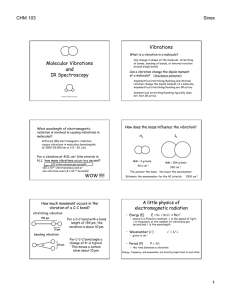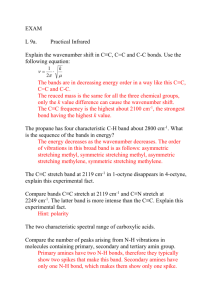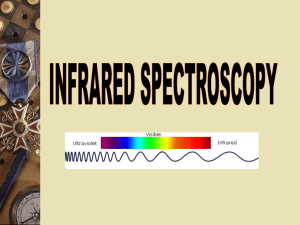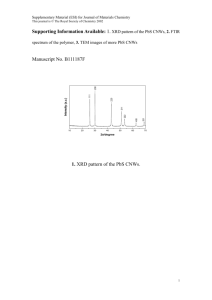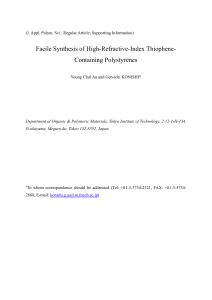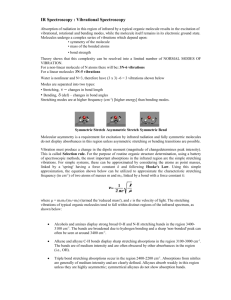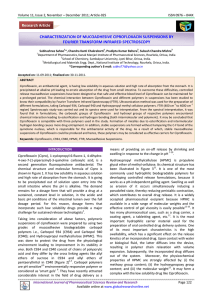Molecules, Motion, and IR Spectroscopy
advertisement
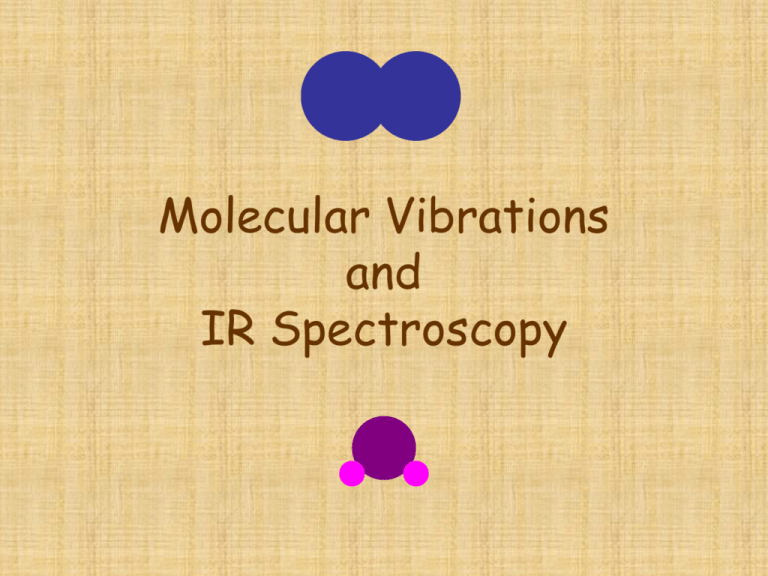
Molecular Vibrations and IR Spectroscopy Vibrations What is a vibration in a molecule? Any change in shape of the molecule- stretching of bonds, bending of bonds, or internal rotation around single bonds Can a vibration change the dipole moment of a molecule? (Shockwave animation) Asymmetrical stretching/bending and internal rotation change the dipole moment of a molecule. Asymmetrical stretching/bending are IR active. Symmetrical stretching/bending does not. Not IR active What wavelength of electromagnetic radiation is involved in causing vibrations in molecules? Infrared (IR) electromagnetic radiation causes vibrations in molecules (wavelengths of 2500-15,000 nm or 2.5 – 15 mm) For a vibration at 4111 cm-1 (the stretch in H2), how many vibrations occur in a second? 120 trillion vibration per second!!!! 120 x 1012 vibrations/sec or a vibration every 8 x 10-15 seconds! WOW !!!!! How does the mass influence the vibration? H2 MM =2 g/mole I2 MM =254 g/mole The greater the mass - the lower the wavenumber How much movement occurs in the vibration of a C-C bond? stretching vibration 154 pm 10 pm For a C-C bond with a bond length of 154 pm, the variation is about 10 pm. bending vibration 4o 10 pm For C-C-C bond angle a change of 4o is typical. This moves a carbon atom about 10 pm. A little physics of electromagnetic radiation • Energy (E) E = hn = hc/l = hcn’ – where h is Planck’s constant, c is the speed of light, n is frequency or the number of vibrations per second and l is the wavelength • Wavenumber (n’) – given in cm-1 • Period (P) n’ = 1/ l P = 1/n – the time between a vibration Energy, frequency, and wavenumber are directly proportional to each other. What type of vibrations would occur in pentane? Let’s examine the IR spectrum of pentane. IR spectrum C-H stretching C-H bending Increasing absorption of IR radiation C-C bending Increasing wavelength Increasing wavenumber (energy, frequency) Increasing absorbance IR Spectra of chloroform and deuterochloroform Shift of peak due to replacement of H with D (2x mass) Mode of vibration CHCl3 CHCl3 CDCl3 Calculated* Measured Measured C-H stretching 3002 3020 2256 C-H bending 1120 1219 912 C-Cl stretching 701 773 737 C-Cl bending 418 671 652 * Spartan ’02 AM1 minimization Some results • Calculated values using computational software give lower wave numbers • Increasing mass of substituted atoms shifts wave numbers to lower values (Excel spreadsheet) • Stretching energies > bending energies > internal rotation energies (occur at higher wavelengths) -1 Wavenumber (cm ) Does the stretching energy have any relationship to the strength of the bond? 5000 Wavenumber vs. Bond Energy 4000 3000 2000 W = 6.3286BE + 401.38 1000 r2 = 0.7979 0 200 300 400 500 Bond energy (kJ/mole) 600 Let’s examine the carbonyl group on three compounds formaldehyde phosgene acetone How does the C=O stretching energy compare for these three molecules? 2053 cm-1 1951 cm-1 2063 cm-1 The carbonyl group has a range of 1700-3000 cm-1. Functional group analysis in organic compounds • Unlike atomic spectroscopy where sharp energy transitions occur due to well quantized electron transitions, molecular spectroscopy tends to show bands. • Molecular vibrations are influenced by the surrounding groups! bending Basic Functional Groups C-H O-H stretching C=O 4000 C-O alkenes aromatic O-H C-H 3000 Ch C C=C 2000 WAVENUMBER (cm-1) C-C 1000 400 Use of IR spectra • Identification of functional groups on a molecule – this is a very important tool in organic chemistry • Spectral matching can be done by computer software and library spectra • Since absorbance follows Beer’s Law, can do quantitative analysis
